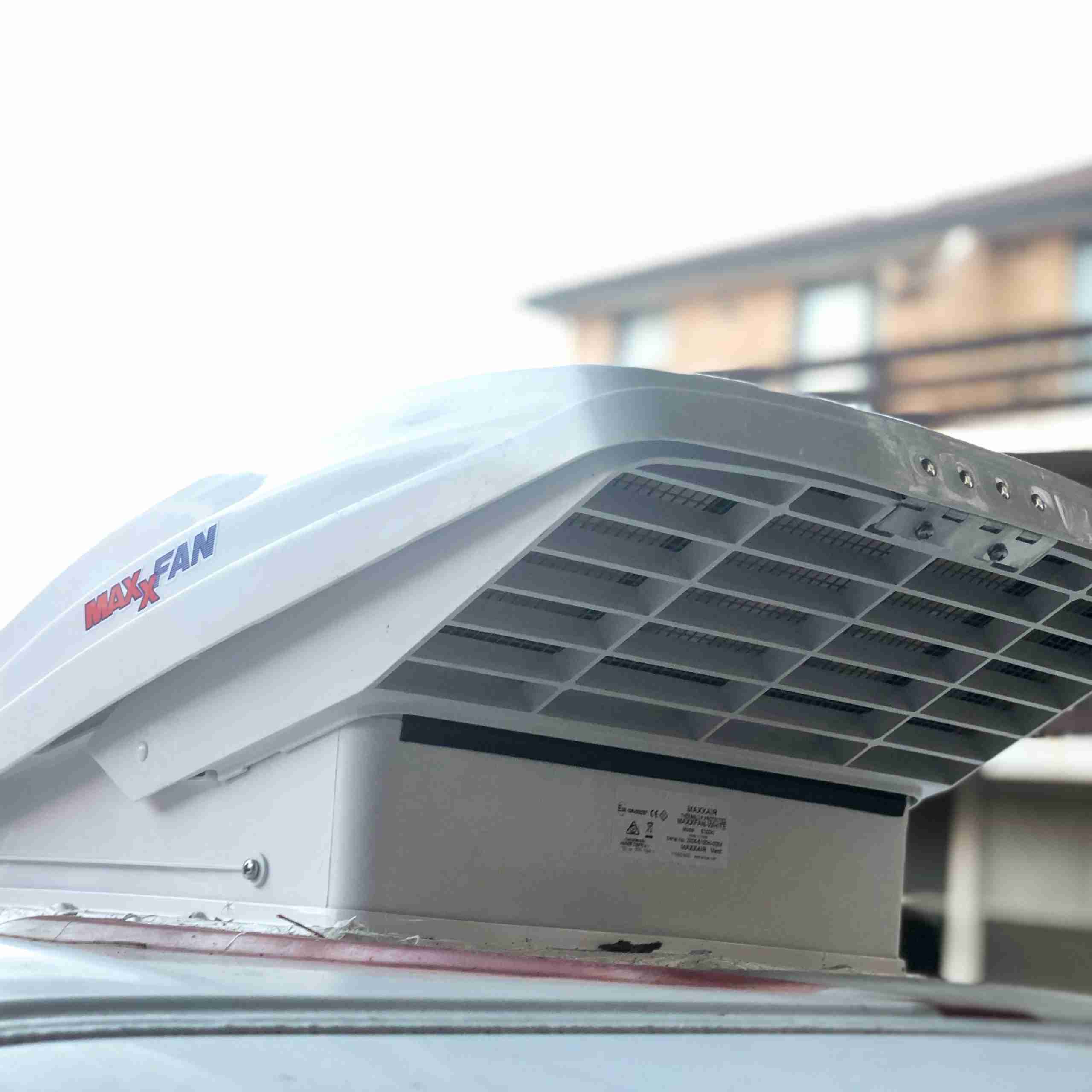Camper Van Roof Vent: The Ultimate Guide For Everything You Need To Know
Updated on: April 2025
It doesn’t matter the size of your van build; you will always need fresh air flowing through your van.
You need adequate camper van ventilation, no matter your camper van conversion size. The ventilation of your van is critical. It prevents the growth of mould and odours that can cause all sorts of issues in your conversion.
Fortunately, there is a simple solution to avoid these problems. You can enjoy lovely fresh, clean, and cool air in your campervan conversion by ensuring it is adequately ventilated.
The ultimate guide to camper van roof vents has everything you need to know. So, if you want to understand how to build an effective ventilation system, regardless of the size of your conversion, keep reading!
This post will assist you in determining how to design the ideal camper van ventilation system possible for your tiny home on wheels, regardless of your budget.
Campervan Ventilation
Understanding ventilation is critical if you’re converting or purchasing a campervan.
It’ll assist you in getting the ventilation you require so that you don’t have to endure the odour of a team changing room on a wet day!
This part explains everything you need to know about campervan roof vents, including why you need them, different types of van ventilation, the best roof vents, and installation hints.

What is a van roof vent for?
A roof vent fan helps to circulate fresh air into your campervan while you’re driving or parked, and it removes any built-up heat or moisture.
This is important because a build-up of moisture can cause the walls and ceilings in your van to become damp, leading to mould growth.
Mould can cause health problems, so installing a roof vent fan is essential to prevent this from happening.
Hot air can also make your camper feel really uncomfortable, especially in the summer months, so a roof vent is a must-have for any campervan.
Why You Should Install Camper Van Roof Vent
There are three distinct purposes for which you might want to add ventilation in your campervan.
- To control the interior temperature to create a comfortable environment.
- To assist in fighting the build-up of moisture, which can contribute to condensation.
- Fight any unwelcome odours and pollutants.
Below, we’ve gone through each one in more depth.
1. Campervan ventilation helps control the internal temperature
The internal environment of your campervan can be controlled by installing camper van roof vents, which are one of, if not the most important reasons for doing so. Because heat rises and cold air sinks naturally, cool air will sink to the bottom, and hot air will rise to the ceiling inside your vehicle.
Furthermore, over time, the accumulation of warm air inside your campervan’s living area will raise the temperature significantly. As a result, the internal space may become too hot and stuffy.
You may regulate the internal temperature of your campervan by installing an efficient ventilation system in the suitable areas. This will make living and travelling in your campervan more enjoyable.
2. Campervan Roof Fan can combat the build-up of Humidity and Condensation
Let’s be honest – having a lot of humidity in a campervan is annoying! That’s why campervan ventilation is so crucial to getting rid of as much moisture as possible in the air.
With high humidity, mould can develop in your van. As a result, you’ll almost certainly produce condensation with a lot of moisture. This might eventually lead to corrosion inside your camper van.
3 – Campervan roof vents Help’s Combat Odour and Pollutants
When many people live in a confined space for an extended time, unpleasant fumes will build up. This is also true in hotter climates, where a human body perspires more.
However, it’s not just humans that produce smells. Dogs and cats are notorious for their fragrant glands that can be found around their mouths and underarms. When you have a pet and they spend time inside the campervan, their smells will become trapped.
Food spillages and dirty dishes can quickly give off a nasty smell even if you’re not travelling with pets. So, it’s important to have a sound ventilation system that can help remove any foul odours before they become too overpowering.
This should aid in the removal of any undesirable scents from the inside of your car by using the correct camper van roof vent system.
Choosing the Best Camper Van Roof Ventilation
When choosing your camper van roof vent, you’ll need to consider several factors. We have put together a list of items you should consider when making your decision.
Noise
Most high-quality fans are very quiet, but some lower quality models can be pretty loud. If you want a roof fan for your campervan that will keep the noise level down and allow light sleepers like yourself to get their beauty rest, then this would be something to consider.
Amperage Draw
Power draw is crucial, considering how your electrical system is set up. Do you have a large battery bank? How much solar do you have installed?
A roof vent with a low amperage draw is very beneficial and will not tax your battery as much as a high amperage draw fan.
The longer you can have your roof vent fan running, the better it will be are reducing condensation and mould.
Increase temperature control
Not only are fans a great way to change the temperature quickly and easily, but they also keep us cool during hot weather by creating airflow.
You are most likely not able to have an air conditioner installed in your van, but if you have a roof top vent, then the air in your car will circulate properly.
It will allow you to control the temperature inside your van on those hot days, keeping you and your family much more comfortable.
Configuration
No matter what size of van you need, a high-quality roof vent offer many different settings. They are designed for maximum airflow and temperature control which is excellent if your van doesn’t have enough ventilation or if it’s too hot inside due to lack of air conditioning during the warmer seasons.
The features might include
- Reversible rotation blades to blow air in our out,
- Built-in thermostat
- Automatically switching off to be energy efficient
- Remote control
- Built-in rain sensor
- Fan speeds
Prevents Condensation and Mould
Without ventilation, your van will quickly become a source of mould and moisture. When you are cooking or sleeping, there will be a build-up of humid air. These particles can penetrate through your van walls to cause damage.
Using roof vent fans help for proper ventilation that can pull out the excess moisture in an area when the fan is running.
Easy installation
A new roof vent installation is quickly done within a few hours. You don’t need to be a professional builder or electrician. The vent usually comes with all the materials you need for a successful installation, such as screws, gaskets and manuals.
Check out our how to install a max air fan.
Improve air quality
A roof vent fan also helps improve air quality by extracting stale, moist air. This can help reduce the number of allergens and particles in the air. If you have asthma or other respiratory problems, a roof fan can be a great way to improve your quality of life while on the road.
So, if you’re looking for ways to improve your campervan’s ventilation system, a roof vent fan is a great option. It is an affordable and easy way to keep your family cool and comfortable while on the road.
Size
Even though custom vent fans are possible, they usually fit within a standard 356×356 cm square. I would recommend staying with a standard size. The benefit would be, if it was to fail and you would like to replace it with a different brand, it can easily be done.
Recap
We recommend using an electric roof vent to have the best camper ventilation possible. It’s one of the most cost-effective and efficient ways to move air.
When choosing a van roof vent for your setup consider:
- How much power do they consume? Make sure your campervan electric design can handle it.
- Two vents can work great together – some roof vent on the one side of the van draws clean, fresh air as the one extracts the humid air.
- The size of your vans electrical system – smaller vans may not need the full power of some of the more powerful models.
- If you’re replacing an existing fan, make sure the opening is correct.
- Ceiling height – can you reach the ceiling controls on a roof vent? If not, consider a remote control for your roof vent.
- Height of the vent cover – oversized shroud can give a shadow over your solar panels and may not be very aerodynamic.



